|

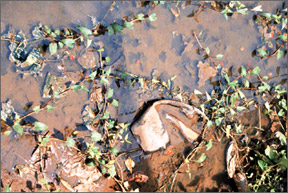 |
|
Littered
water |
 |
|
Unprotected
stream |
|
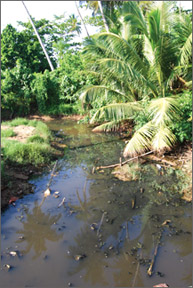 |
|
Dirtied
water |
 |
|
Interdependent creatures |
Like the flowing river
River restoration, need of the hour :
Priyanka Kurugala
Natural features such as rivers, waterfalls, marshy lands and
wetlands are important places where water plays an important role in
terms of biology, ecology and water chemistry.
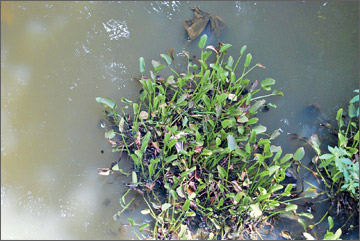 |
|
Streams
badly need restoration. Pictures by Dr Wasantha S Weliange |
Maintaining such habitats in a natural way is important for the well
being of human beings. Present day tourism is based on observing and
enjoying nature to improve the intellectual well being of the man.
Therefore conserving and maintaining watery habitats is a must for a
country. The culture, heritage and economics are strongly bound with it.
On the other hand tourism is basically dependent on beauty and freshness
of the landscape of a country. Therefore protection and conservation of
nature has a direct relationship to the economy of a country.
Dr Wasantha S Weliange of the Kelaniya University researches about
how rivers function in Sri Lanka. He points out following steps to
improve water habitats in Sri Lanka; particularly in Colombo. One of the
four major rivers, Kelani flows to the sea from Colombo across Western
Province in Sri Lanka. Diyawanna stream which runs closer to the
Parliament is a tribute to the Kelani River and has subjected to
legendary poems such as Selalihini Sandesa. Other than these two rivers,
there are numerous canals built during the Dutch period for
transportation. It is pathetic to notice that nobody needs to mediate or
take real action to safeguard these important habitats to improve the
well being of humans and the beauty of nature.
Although during the past those Dutch canals were used for
transportation of goods presently they are just canals which transport
garbage and sewerage. Many industries directly discharge their polluted
industrial effluents into water resources while others discharge all
sort of unwanted materials into canals. This leads to foul smells and
inappropriate scenes.
Water is more important as a natural resource than fresh air. Water
running in these canals is not fit to any important things, or for
survival of animals and plants that benefit man or ecosystem but
bacteria, worms and pathogens can cause severe diseases to man and other
animals. Completely black and turbid water carry oils, paints and many
other industrial wastes to sea though these canals. The slow flow
through the canal increases the ground water pollution and the polluted
water seeps through the earth.
Heavy metals and non-degradable chemicals dissolve into the
groundwater and pollute making it unsuitable for human use. Slowly
flowing water provides the best conditions and habitats for mosquitoes
and other blood-sucking insects to increase their population. On the
other hand canal banks are made of large cobbles which provide spaces
for rats and cockroaches to live. The beauty of flowing water no longer
could be seen as beautiful, but something that carries dirt, sewerage,
solid wastes and water plants such as Icornia species. About 30 years
ago most rivers and waterways faced the same situation in many other
western countries. Nevertheless they were able to restore rivers and
bring back the life to those streams.
The flowing water has lots of life. Dr Welianga has found out that in
one square metre in the river bottom, there are around 4000 young stages
of insects that belong to mayflies, stoneflies, beetles, caddis and
dragon flies living. All those creatures carry out an important task for
keeping the river healthy. They eat dirt or any organic waste coming to
the water. They also help control the menace of insects such as
mosquitoes and blood sucking creatures such as biting midges.
Those insects living in the river bottom become food for fish while
they grow in the water. Once becoming adults they come out from the
water’s surface and become food for birds and bats. Destruction and
construction are both a possible act. River restoration, therefore,
should be given prominence.
River restoration
River restoration is the act of working with a degraded river or
stream in order to return it to a pre-disturbed condition. A disturbance
is anything that disrupts a stream and knocks it out of equilibrium.
Common disturbances in Lancaster County result from suburban sprawl and
agriculture. These land use practices cause excess sediment, nutrients,
and chemicals to run into the water. Restoration projects work on
different scales. A reach is a small section of a stream, while a
corridor is the entire length of the stream.
<<<<<<<<<<>>>>>>>>>>>
Watersheds
A watershed is an area of land that contributes water to a common
network of streams. Watershed boundaries or ‘divides’ occur along high
points in the landscape that separate different stream networks. Large
watersheds are composed of many smaller watersheds upstream of the
primary river in the network. All streams in the Little Conestoga
watershed flow into the Conestoga River, then into the Susquehanna River
which flows into the Chesapeake Bay. Each stream or river in the
watershed is called a tributary of the larger river downstream.
<<<<<<<<<<>>>>>>>>>>>
Types of Restoration
There are many components to stream restoration. Most common efforts
focus on stream bank stabilization, enhancing riparian buffers by adding
trees and natural grasses, the removal of dams and other man-made
structures, adding meanders, and stocking the river with fish or other
living organisms.
<<<<<<<<<<>>>>>>>>>>>
Streambank Stabilization
Basic streambank stabilization may involve placing large cobbles or
boulders along banks and replanting native vegetation. More
sophisticated stabilization procedures include ‘vegetated geogrids,’
where alternating layers of live branches, called fascines, are buried
along the stream bank.
These can be installed along with ‘live stake’ cuttings inserted
upright into the soil. Banks can further be stabilized using ‘biologs’
(bundles of coconut fibers) placed at the bottom of a stream bank to
hold the bank in place. ‘Rootwads’ are uprooted trees installed into the
stream bank with the roots facing into the channel. These structures
encourage different speeds of water flow where different organisms can
live. They also serve to trap sediment, stop erosion, and prevent
damaging effects from pollution.
<<<<<<<<<<>>>>>>>>>>>
Riparian Buffers
Planting trees and grasses creates a ‘green sponge’ that filters
water flowing into the stream and traps excess sediment. Sediment is
problematic because it blocks light to underwater vegetation and lowers
the water oxygen levels that fish and other organisms need to survive.
These sponges are called riparian buffers. Riparian buffers are planted
next to streams and are ideally 20 to 30 feet wide on either side of the
river.
Small dams and other structures were put into place around Lancaster
to power mills. However, most dams are unnecessary today. Dams harm
streams by blocking fish from their native spawning grounds.
www.littleconestoga.org
Genghis Khan the green
Chamari Senanayake
Recently, a study held by Carnegie Institution’s department of
Ecology measured the carbon impact of a number of historical events that
involved a large number of human deaths.
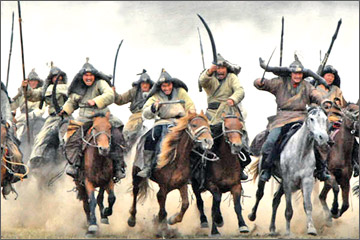 |
|
In outer Mongolia in temperatures of
minus 30 degrees these photographs of the legendary horses
descended from the beasts that Genghis Khan’s men rode in
the 13th century has been taken. www.bnps.co.uk |
Time periods looked at also included the Black Death in Europe, the
fall of China’s Ming Dynasty and the conquest of the Americas. According
to the study, the legendary Genghis Khan has given the biggest helping
hand to the earth’s environment, by killing so many people. After his
murderous conquests killed so many people that huge swathes of
cultivated land returned to forest and helped remove nearly 700million
tons of carbon from the atmosphere.
At a time like this where affects of Global warming could been seen
everywhere in devastating scales, in the forms of unusual floods,
landslides, draughts and melting of Glaziers which affect the lives of
thousands of animal species such as Polar Bears and Penguins, no one but
the man-kind is to be blamed for these catastrophes. With our industrial
revolutions and never ending carbon emission to the atmosphere, ever
growing populations and clearing of forests to accommodate human
population and many other human activities has become the focus as the
main reasons for Global warming. In other words, expansion of human kind
has brought devastating affects to our mother earth.
Julia Pongratz, who headed the research by the Carnegie Institution’s
Department of Global Ecology says that humans started to influence the
environment thousands of years ago by changing the vegetation cover of
the Earth’s landscapes when we cleared forests for agriculture, and the
deaths of 40million people as a result of Genghis Khan’s invasions meant
that large areas of cultivated land grew thick once again with trees,
which absorb carbon dioxide from the atmosphere. Even the events like
Black Death in Europe share a widespread return of forests after a
period of massive depopulation. But the bloody Mongol invasion, which
lasted more than a century and led to an empire that spanned 22 per cent
of the Earth’s surface, immediately stood out for its longevity and
bigger effect.
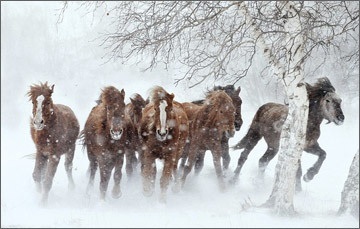 |
|
Mongol horses were small, but their
riders were lightly clad and they moved with greater speed,
which later made them the most successful invaders in human
history. |
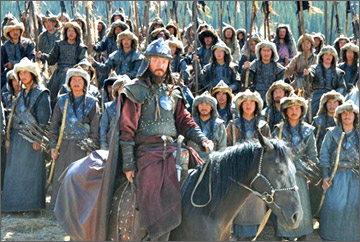 |
|
An actor portraying legendary Genghis
Khan from the award winning movie ‘Mongol’. |
And this is how Genghis Khan, who repeatedly wiped out entire
settlements, was able to scrub more carbon from the atmosphere than any
other invader. After his decades long invasions, and also of his sons
and grandsons, the earth is believed to have cooled down.
Genghis Khan was born under the name, Temujin and his father was khan
of a small tribe, but he was murdered when Temüjin was still very young.
After that, with his mother and five other children, Temüjin was cast
out and left to die. From the most brutal beginning possible, Genghis
survived to unite the Mongolian tribes and conquer territories as far
apart as Afghanistan and northern China. He left a mountain of skulls
that remained for years in China. In one instance, the city of Nishapur
revolted against Mongol rule. The husband of Genghis Khan’s daughter was
killed, and, it is said, she asked that everyone in the city be put to
death, and, according to the story, they were.
Kidnapping of women had often caused feuding among the Mongols, and,
as a teenager, Temujin had suffered from the kidnapping of his young
wife, Borte. After devoting himself to rescuing her, he made it law that
there was to be no kidnapping of women. He declared all children
legitimate. He made it law that no woman would be sold into marriage.
The stealing of animals had caused dissension among the Mongols, and
Genghis Khan made it a capital offense.
Mongolian horses are often credited for the successes of Mongol
invasions, and in history these Mongolian horses stand out as legendary
figures as warhorses. Even today in the snowy wilds of Mongolia the
descendants of Genghis Khan’s horses has become a ‘hard to reach’
tourist attraction. Mongol horses were small, but their riders were
lightly clad and they moved with greater speed. These were hardy men who
grew up on horses and hunting, making them better warriors than those
who grew up in agricultural societies and cities. Their main weapon was
the bow and arrow.
It is widely popular that Genghis Khan declared freedom of religion
throughout his empire. Favoring order and tax producing prosperity, he
forbade troops and local officials to abuse people. In 1227, around the
age of sixty-five while leading the fighting against the Tangut, Genghis
Khan, it is said, fell off his horse and died. Genghis Khan paved the
way for his grandson Kublai Khan to become emperor of a united China and
founder of the Yuan dynasty. In all, Genghis conquered almost four times
the lands of Alexander the Great. |



